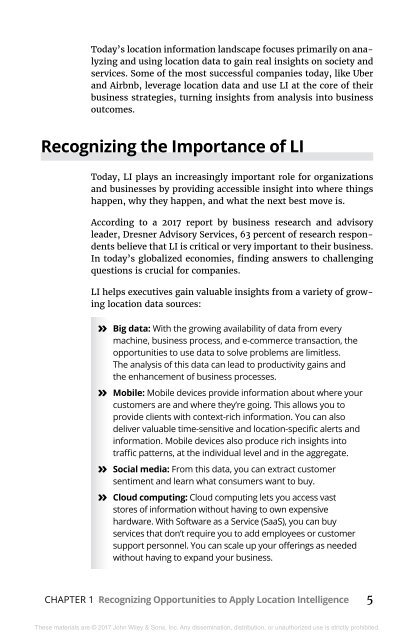Location-Intelligence-For-Dummies-ebook
Create successful ePaper yourself
Turn your PDF publications into a flip-book with our unique Google optimized e-Paper software.
Today’s location information landscape focuses primarily on analyzing<br />
and using location data to gain real insights on society and<br />
services. Some of the most successful companies today, like Uber<br />
and Airbnb, leverage location data and use LI at the core of their<br />
business strategies, turning insights from analysis into business<br />
outcomes.<br />
Recognizing the Importance of LI<br />
Today, LI plays an increasingly important role for organizations<br />
and businesses by providing accessible insight into where things<br />
happen, why they happen, and what the next best move is.<br />
According to a 2017 report by business research and advisory<br />
leader, Dresner Advisory Services, 63 percent of research respondents<br />
believe that LI is critical or very important to their business.<br />
In today’s globalized economies, finding answers to challenging<br />
questions is crucial for companies.<br />
LI helps executives gain valuable insights from a variety of growing<br />
location data sources:<br />
»»<br />
Big data: With the growing availability of data from every<br />
machine, business process, and e-commerce transaction, the<br />
opportunities to use data to solve problems are limitless.<br />
The analysis of this data can lead to productivity gains and<br />
the enhancement of business processes.<br />
»<br />
» Mobile: Mobile devices provide information about where your<br />
customers are and where they’re going. This allows you to<br />
provide clients with context-rich information. You can also<br />
deliver valuable time-sensitive and location-specific alerts and<br />
information. Mobile devices also produce rich insights into<br />
traffic patterns, at the individual level and in the aggregate.<br />
»»<br />
Social media: From this data, you can extract customer<br />
sentiment and learn what consumers want to buy.<br />
»»<br />
Cloud computing: Cloud computing lets you access vast<br />
stores of information without having to own expensive<br />
hardware. With Software as a Service (SaaS), you can buy<br />
services that don’t require you to add employees or customer<br />
support personnel. You can scale up your offerings as needed<br />
without having to expand your business.<br />
CHAPTER 1 Recognizing Opportunities to Apply <strong>Location</strong> <strong>Intelligence</strong> 5<br />
These materials are © 2017 John Wiley & Sons, Inc. Any dissemination, distribution, or unauthorized use is strictly prohibited.


